The term waterfowl is used to describe any member of the order Anseriformes. A series of articles describes all the waterfowl. This specific article describes the "swans and geese" which belong to family Anatidae, subfamily Anserinae.
Anseriformes
Most species of the order Anseriformes spend a considerable amount of time in water. In fact, they are called waterfowls. Their webbed feet make for efficient swimming. A few species spend little time in water and thus their feet are only partially webbed. Most waterfowl are also good flyers, many migrating long distances to escape the cold and others migrating shorter distances for optimizing their food supply. All species, except the screamers, have a wide and relatively flat bill. The shape of a species bill and also their tongue is a function of their diet. Considering the entire order, they eat aquatic plants, grasses, sedges, algae, plankton, insects, insect larvae, mollusks, crustaceans, fish, fruits, grains, rice. Most species are monogamous and if they lose a partner seem to mourn. Males are larger and heavier than females. The chicks are well developed when they hatch and can walk almost immediately.
The order Anseriformes has 3 familes: Anatidae, Anhimidae, Anseranatidae. Family Anatidae is comprised of the ducks, swans, and geese which amounts to about 160 species. Family Anhimidae is made up of 3 screamer species while family Anseranatidae has only one species, the magpie goose. Since these latter two families contain so few species, it seems appropriate to consider the entire order in this series of articles.
Anatidae
The Anatidae family has the following subfamiles:
Anatinae: dabbling ducks and teals
Anserinae: geese, swans
Aythyinae: diving ducks
Dendrocygninae: whistling ducks
Merginae: sea-ducks
Oxyurinae: stiff-tailed ducks
Plectropterinae: spur-winged goose
Stictonettinae: freckled duck
Tadorninae: shelducks, shelgeese
Swans
Swans are the largest waterfowl, substantially larger than the other members of their subfamily, geese.They wingspans are over 3 m (10 ft). Hundreds of years ago they used to be considered a luxury food reserved for royalty; it was then taboo for commoners to hunt swan. In the present day that feeling of taboo is renforced by their beauty and their perceived scacity. "Perceived" scarity because in some places the swan population has increased to the point where they are pests. While it may seem logical to allow swan hunting in such cases, most national or local govermentss still protect swans.
The sexes are alike in appearance, but the males are larger. Most swans mate for life, their divorce rate is only about 3%. When it is time to procreate, they have a courtship behavior where they nod their heads towards each other while shaking their wings. The males help with nest construction and also with incubation of the eggs. Perhaps because the sexes share household duties that helps explain their low divorce rate. Swans molt in the summer and then are unable to fly for about 6 weeks. Not flying at that time is not very inconvenient as they are raising the young and there is still plenty of time before migration season. Swans fly with their necks extended and they often a V-shapes as is true for geese. The reason some flocks fly in V-shape has to do with aerodynamics. The leader has more air resistance, thus helping the ones behind it. After a white, the lead position rotates and someone else has to push the air aside. A V-shaped formation is especially important for large birdes. Pelicans also frequently travel this way.
Swans live in temperate climates. Many breed in the arctic when it is relatively warm, but leave for warmer climates when the juveniles are able to fly. Swans often forage on water. They eat roots, tubers, stems and leaves of aquatic and submerged plants.With their long necks much vegetation is usually within reach. And that reach can be extended if the go "bottoms up" and dabble like a duck. Swans also forage in fields paying special attention to the dregs of crops in winter fields. In addition to plants, some swans eat insects, mollusks, and crustaceans.
The Coscoroba Swan belongs to its own genus Coscoroba. It is considered as an early branch from the common ancestor leading to true geese and swans.
Geese
Geese are large waterfowl, larger than ducks and smaller than swans. They are amount the earliest animals that were domesticated, at least 3000 year ago in Egypt. and perhaps sooner. The early domestication must have been aided by geese imprinting on its caregiver at birth. Thus the new goosling would treat their handler as a parent and not try to escape or bite the hand that fed it. Another benefit of a domesicated goose is that the honk when there is an intruder, whether that be a fox or a human intruder, and will try to drive it off.
Like the swans, geese fly in V's because it saves energy. They honk frequently while flying probably to encourage the flock to stay together and in formation, akin to a coxman in racing shell. The honking also serves to attrack other geese to their journey. That honking also alerts hunters and. of course, can be detrimental to the health of a goose, but the larger the skein (yes, skein refers to a flock on flying geese, not just a coil of yarn) the lower the odds of getting shot for any individual goose. Other geese related words: a gaggle is a group of geese on the ground; a gander is a male goose; and a goosling is a young geese.
Some other ways that geese are similar to swan's:
Male larger than female
When they moult they cannot fly; then like to be near water for protection from predators.
Monogomous - usually stay with the same partner for life.
Many migrate long distances.
Fly with next outstretched, rest with the neck in an S shape.
The sexes are dimorphic in appearance. This is yet another way that geese are similar to swans. But the geese have an exception - the three species in genus Nettapus, the pygmy geese, are dimorphic. Their nearest relatives are unclear, and they may not rightfully belong ot the swan and goose subfamily Anserinae. This lack of dimorphism is one reason why. The extreme size difference between true geese and pygmy geese is another.
Most geese species are mainly vegetarians. Many will dabble for aquatic food, but even the species that graze mainly on the land prefer to live close to water for protection as all geese are excellent swimmers. Taken as a whole, gease will eat aquatic vegetation, algae, grasses, sedges and kelp. Some specices will eat insects, small fish, and crustaceans. In the winter time when greens are harder to find most geese will the dregs of crop fields such as corn and other grains, rice, beans, and even potatioes.
The cape barren goose belongs to its own genus Cereopsis. It It may belong to the goose and swan subfamily Anserinae or to the shelduck subfamily Tadorninae. The freckled duck, Stictonetta naevosa, has been assigned to its own subfamily Stictonettinae. It is thought to be closest to the cape barren goose. The spur-winged goose belongs to its own genus Cereopsis and own subfamily Plectropterinae. The magpie goose, Anseranas semipalmata, does not belong to the swan and goose subfamily Anserinae. Stranger still it does not belong to the family Anatidae; it is alone in its own family Anseranatidae.
.
Genus Coscoroba - 1 species
Swan, Coscoroba Coscoroba coscoroba
Range: South America (southern).
Habitat: Well-vegetated swamps and lagoons.
Diet: Vegetation, aquatic insects, small fish.
Conservation status: Least Concern.




Genus Cygnus
Swan, Bewick's Cygnus bewickii
The Bewick's swan of Europe / Asia and whistling swan of North America are sometimes considered to be subspecies of the tundra swan. In that case they are identified as Cygnus columbianus bewickii and Cygnus columbianus columbianus. Since their heads coloration is decidedly different, the two species approach is followed here.
Range: Europe, Asia.
Habitat: In breeding season it frequents shallow waterbodies in the Arctic tundra. Otherwise visits fields and marshes.
Diet: Aquatic vegetation, grains from fields, mollusks, crustaceans.
Conservation status: Least Concern.




Swan, Black Cygnus atratus
Range: Native to Australia. Introduced: New Zealand, North America, Europe.
Habitat: A variety of wetlands with underwater and emergent vegetation: fresh, brackish and salt water lakes, swamps and rivers.
Diet: Aquatic plants, but also grass and leaves.
Conservation status: Least Concern.




Swan, Black-necked Cygnus melancoryphus
Range: South America.
Habitat: Fresh or brackish water with submerged vegetation.
Diet: Vegetation, insects, and small fish.
Conservation status: Least Concern.


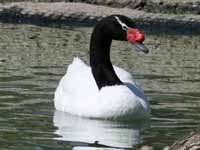
Swam, Mute Cygnus olor
Range: North America (introduced), Europe, Asia, Africa.
Habitat: Sheltered freshwater, brakish, or salt water bodies.
Diet: Aquatic plants and also vegetation on land. They can cause crop damage by eating grains and also trampling the plants.
Conservation status: Least Concern.

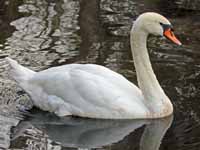


Swan, Trumpeter Cygnus buccinator
Range: North America.
Habitat: Relatively large ponds and lakes so there is ample room for launching into flight. The water body must have vegetation, good quality water, and little human disturbance.
Diet: Mainly aquatic plants, but also grasses and grains in the winter. Young birds will eat insects, small fish, and crustaceans.
Conservation status: Least Concern.
1) Juvenile

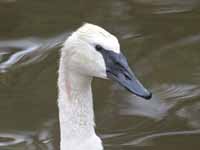


Swan, Whistling Cygnus columbianus
The Bewick's swan of Europe / Asia and whistling swan of North America are sometimes considered to be subspecies of the tundra swan. In that case they are identified as Cygnus columbianus bewickii and Cygnus columbianus columbianus. Since their head coloration is decidedly different, the two species approach is followed here.
Range: North America.
Habitat: In breeding season it frequents shallow waterbodies in the Arctic tunda. Otherwise visits fields and marshes.
Diet: Aquatic vegetation, grains from fields, mollusks, crustaceans.
Conservation status: Least Concern.



Swan,_Whooper Cygnus cygnus
Range: North America, Europe, Asia, Africa.
Habitat: Breeds near shallow vegetated freshwater, preferably in a wooded area. In the winter they can be found at protected coastal areas as well as agricultural fields.
Diet: Aquatic vegetation, grains, grasses, mussels.
Conservation status: Least Concern.
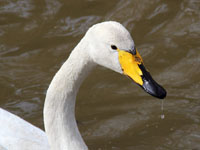
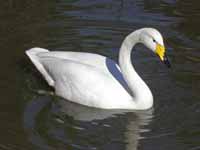


Anser and Branta are the two genera that comprise the true geese. The Cape Barren goose, spur-winged goose, and magpie goose are not true geese. Similarly, many species termed goose actually belong to the shelduck subfamily. The closest relatives of the true geese are the swans of genus cygnus. Many geese species spend most of their tme on land. But they often retreat to water if they feel threated. With their webbed feet thet are excellent swimmers.
Genus Anser
The "grey" geese of genus Anser are closely related to the "black" geese in genus Branta. Anser geese have pink or orange legs and feet; Branta geese have black or dark-grey legs and feet. Also the typical Branta goose has more black on its head and neck than does the typical Anser goose. The "white geese" are a small group of waterfowl which used to be placed in genus Chen, but are now placed in Anser. They breed on subarctic areas of North America and around the Bering Strait, migrating south in winter.
Goose,_Bar-headed Anser indicus
Range: North America (escaped captives ), Asia.
Habitat: High altitude lakes and fields in the summer. Lowland wetlands in the summer.
Diet: Forages mainly on land eating grasses, sedges, seeds, berries. Also eats grains, kelp, small crustaceans.
Conservation status: Least Concern.
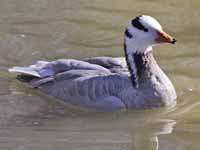



Goose,_Chinese
The dark versions below might be swan geese.


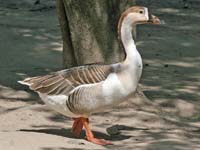

Goose,_Emperor Anser canagica
Range: west North America (Alaska to northern California), Asia (northeast Siberia).
Habitat: Breeds on tundra, usually in marshes within 15 km (10 miles) from the coast. Migrates south about 700 km (400 miles) to ice free regions, again staying near the coast. Because of its coastal preference it is also known as the beach goose.
Diet: Vegetation in summer. Mussels, algae in winter.
Conservation status: The emperor goose is considered to be Near Threatened due to hunting and pollution.
1) Head stained oranged from iron-rich water.




Goose,_Greater White-fronted Anser albifrons
Range: North America, Europe, Asia.
Habitat: Breeds in tundra near wetlands. Winters in open country near salt or freshwater wetlands. Also winters near farmland.
Diet: Aquatic and terrestrial vegetation, seeds, grains.
Conservation status: Least Concern.




Goose,_Greylag Anser anser
Range: North America (escaped captive), Europe, Asia.
Habitat: Breeds mainly in northern Europe and Asia near fresh water In winter, in addition to freshwater wetlands, it visits also estuaries and salt water marshes, fields.
Diet: Mainly grasses. Also aquatic vegetation, cereals, beans, small fish, crustaceans, insects.
Conservation status: Least Concern.
6) Greylag / Domestic Goose hybrid




Goose,_Lesser White-fronted Anser erythropus
Range: Europe, Asia.
Habitat: Breeds in lightly wooded tundra. Winters in open country near salt or freshwater wetlands. Also winters near farmland.
Diet: Grazes on grasses and emerging greens of brush.
Conservation status: The lesser white-fronted goose is considered to be Vulnerable because of hunting, nesting disturbances, and habitat modification.




Goose,_Pink-footed Anser brachyrhynchus
Range: Europe including Greenland.
Habitat: Breeds on rocky areas of Grassland and other islands but requires green areas for grazing. Migrates in the fall to northwest Europe grassy areas, crop fields, estuaries.
Diet: Wide variety of greens, plus seeds, grains.
Conservation status: Least Concern.



Goose,_Ross's Anser rossii
Range: North America.
Habitat: They breed in the tundra and migrate south for agricultural fields and shallow wetlands.
Diet: Grasses, dregs of agricultural crops.
Conservation status: Least Concern. The Ross's goose used to be considered Vulnerable, but its population has increased because of conservation efforts.
4) Dark morph




Goose,_Snow Anser caerulescens
Range: North America.
Habitat: Breeds in the tundra near wetlands. Spends much of its time leisurely migrating, stopping at agricultural fields. Winters along the coasts in esturaries, inland wetlands, or fields.
Diet: Grasses, grains, emergent brush grown, crops, crop stubble.
Conservation status: Least Concern.
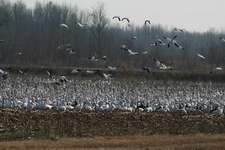



Goose,_Swan Anser cygnoides
Range: North America (introduced/domesticated), Asia.
Habitat: Breeds in highlands near freshwater or brackish wetlands, grassy areas. Winters at lower elevation such as mudflats, rice fields, marshes.
Diet: Grasses, sedges, rice.
Conservation status: The swan goose is consider Vulnerable because of hunting and habitat loss.



Goose,_Taiga Bean Anser fabalis
Range: Europe, Asia.
Habitat: Breeds in wetlands in taigra region (northern boreal forest of Europe). Winters near open areas, such as fields where beans were grown, hence the name.x
Diet: Grasses and similar vegetation; grains, beans, and other agicultural crops.
Conservation status: Least Concern.



Goose,_Tundra Bean Anser serrirostris
Range: Europe, Asia.
Habitat: Breeds in wetlands in tundra region (northern treeless area of Asia). Winters near open areas, such as fields where beans were grown, hence the name.
Diet: Grasses and similar vegetation; grains, beans, and other agricultural crops.
Conservation status: Least Concern.
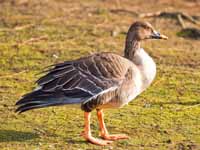


Genus Branta
The Branta geese can be distinguished from other geese by their legs and feet, which are black or very dark grey. Furthermore, they have black bills and large areas of black on the head and neck.
Brant Branta bernicla
Range: North America, Europe, Asia
Habitat: It breeds in tundra regions of North America, Europe and Asia.near the coast. It winters along the Atlantic and Pacific coasts of these continents at mudflats, estuaries. Also resides further inland in agricultural fields.
Diet: Eel grass and other grasses, algae, sea lettuce, cereals.
Conservation status: Least Concern.




Goose,_Barnacle Branta leucopsis
Range: North America (rare), Europe.
Habitat: Breeds in Greenland, islands north of Norway, and northwest Russia where they nest on cliffs then feed on lower land near water bodies. Winters in Great Britain and northwest Europe on meadows, mudflats, and salt marshes.
Diet: Grasses, sedges, grains, aquatic plants.
Conservation status: Least Concern.




Goose,_Cackling Branta hutchinsii
Range: North America, far eastern Asia.
Habitat: Breeds in northern Canada and Alaska in a variety of tundra habitats. Winters as far south as northern Mexico. Winter habitat varies from fresh and salt water wetlands to grassy fields and croplands.
Diet: Mainly vegetarians. When feeding in water, they may dabble like a duck. Also feed on leftovers in cultivate fields, insects, crustaceans.
Conservation status: Least Concern.
4) Canada goose and cackling goose




Goose,_Canada Branta canadensis
Range: North America, Europe, Asia, New Zealand (introduced).
Habitat: Traditionally Canada geese have migrated south during the winter, but many locals in the US now have permanent populations. They require nearby wetlands, but are contest to graze on lawns or beg fo food.
Diet: Mainly vegetarians eating aquatic plants, terrestrial grasses and grains. Also insects, mollusks, crustaceans.
Conservation status: Least Concern.




Nene Branta sandvicensis
The Nene is believed to have evolved from visiting Canada geese about 500,000 years ago.
Similar to: Canada Goose. Canada Goose has black neck; most of Nene's neck is light colored.
Range: Hawaii.
Habitat: Mainly found in grassy areas such as meadows, parks, golf courses. Humans have altered much of Hawaii, so it has had to adapt and has managed fairly well.
Diet: Vegetation, both native and invasive, including grasses, seeds, and even flowers.
Conservation status: The nene is Vulnerable because of habitat loss, the mongoose, and feral cats. The good news is that its is a Hawaiian icon and breeds well in captivity. The bad news is that there are only about 1000 nene in the wild.
4) The Nene has a partially webbed foot.




Goose,_Red-breasted Branta ruficollis
Range: Europe, Asia.
Habitat: Breeds in the tundra of Siberia, near water. Winters close to the Black Sea where there are grasses and perhaps crop dregs available.
Diet: Grasses, sedges, aquatic plants, grains.
Conservation status: The red-breasted goose is consider Vulnerable and estimated to have a population of around 50,000. The main threat to the species may be hunting, but it is also affected by loss of habitat and wind turbines are thought by some to be detrimental too.


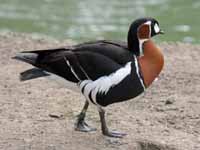
Genus Cereopsis - 1 species
The cape barren goose belongs to its own genus Cereopsis. It It may belong to swan and goose subfamily Anserinae or to the shelduck subfamily Tadorninae. It will be treated here as part of Anserinae.
Goose,_Cape Barren Cereopsis novaehollandiae
Range: Australia.
Habitat: Breeds on grassy islands of the Australian coast. Other times of the year it prefers fields, marshes.
Diet: Grasses, sedges, cereal crops.
Conservation status: Least Concern.
Image by: 1) JJ Harrison 2) Dick Daniels - Sylvan Heights 3) Dick - Australia 4) Ed_Dunens Video by Avibirds




Genus Nettapus
The Pygmy geese are a group of very small "perching ducks" in the genus Nettapus which breed in the Old World tropics. They are the smallest of all waterfowl. There nearest relatives are unclear. They are grouped here with the swan and goose subfamily Anserinae mainly because of "goose" being part of their name. They are probably closer to the dabblng ducks of subfamily Anatinae, but even that relationship is distant. That said, they do feed by dabbling.
Goose,_African Pygmy Nettapus auritus
Range: Sub-Saharan Africa and Madagascar.
Habitat: Slow flowing or stagnant water with a cover of water lilies. Also swanps, river pools, estuaries.
Diet: Aquatic plants and their seeds, insects, small fish.
Conservation status: Least Concern.
1) Pair (female on left) 2) Female 3, 4) Male




Goose,_Cotton Pygmy Nettapus coromandelianus
Range: India, south China, southeast Asia, Australia.
Habitat: Prefer lakes and ponds with emergent vegetation.
Diet: Aquatic plants, insects, crustaceans, mollusks.
Conservation status: Least Concern.
1 - 3) Female 4 - 7) Male



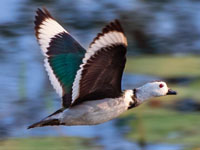
Goose,_Green Pygmy Nettapus pulchellus
Range: Australia, southern New Guinea
Habitat: Vegetated lowland lagoons and other permanent fresh waters.
Diet: Aquatic plants, insects, crustaceans, mollusks. Feeds like a dabbling duck.
Conservation status: Least Concern.
1, 2) Female 3, 4) Male




Genus Plectropterus - 1 species
The Spur-winged Goose is related to the geese and the shelducks, but distinct from both of these in a number of anatomical features, and therefore placed in its own subfamily, the Plectropterinae.
Goose,_Spur-winged Plectropterus gambensis
Range: Africa.
Habitat: Grasslands with lakes, seasonal pools, rivers, swamps and river deltas.
Diet: Grasses, sedges, aquatic plants, and agricultural grains.
Conservation status: Least Concern.
1, 2, 3, 4) Northern Spur-winged Goose (P. g. gambensis) 5 -8) Black Spur-winged Goose (P. g. niger)





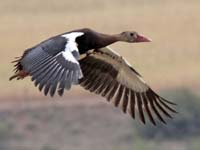


The only member of this subfamily is the freckled duck, it roots may predate the duck subfamily. It is thought to be closest to the cape barren goose.
Genus Stictonetta - 1 species
Duck,_Freckled Stictonetta naevosa
Range: Australia.
Habitat: Breeding sites usually large bodies of water such as flooded wetlands with thick vegetation. At other times, it prefers permanent bodies of water such as lakes, reservoirs, and ponds with less vegetation.
Diet: Aquatic vegetation, insects, algae, larvae and crustaceans. It uses the bill to strain food from mud or sand.
Conservation status: Least Concern.
1) Chick 2, 3) Female 4) Male




